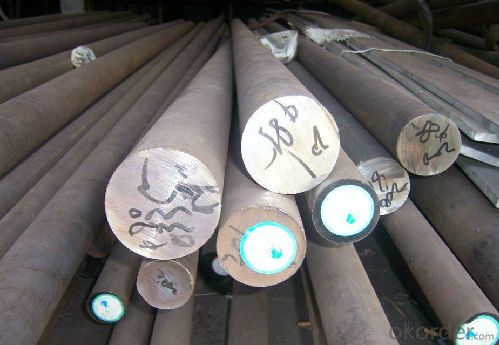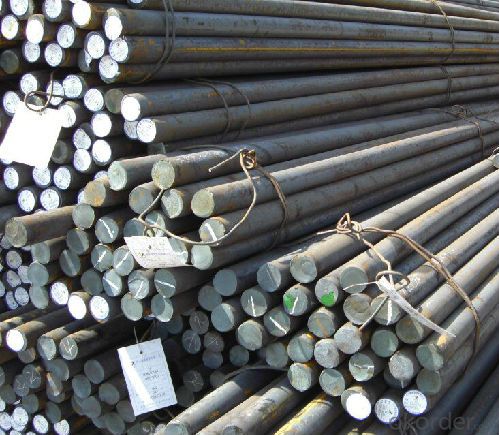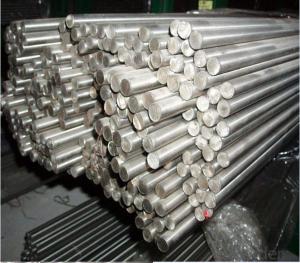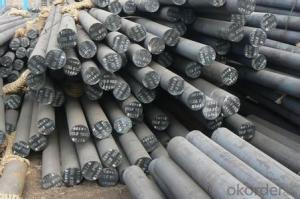cold drawn steel round bar to Aisa market
- Loading Port:
- Tianjin
- Payment Terms:
- TT or LC
- Min Order Qty:
- 5000 m.t.
- Supply Capability:
- 35000 m.t./month
OKorder Service Pledge
OKorder Financial Service
You Might Also Like
Specifications of Carbon Steel Round Bar
1. Grade: Q235, SS400, S235JR, A36
2. Sizes: Diameter: 6mm-150mm; Length: 6m, 9m, 12m or as customer’s request
3. Type: Mild steel; Low carbon steel
4. Shape: Round bar, solid bar of steel with circular section
5. Technique: Hot rolled or cold drawn
6. Mass: Mass(kg/m) = Diameter(mm)×Diameter(mm)×0.00617
Steel Type | Maximum forging temperature (°F / °C) | Burning temperature (°F / °C) |
1.5% carbon | 1920 / 1049 | 2080 / 1138 |
1.1% carbon | 1980 / 1082 | 2140 / 1171 |
0.9% carbon | 2050 / 1121 | 2230 / 1221 |
0.5% carbon | 2280 / 1249 | 2460 / 1349 |
0.2% carbon | 2410 / 1321 | 2680 / 1471 |
3.0% nickel steel | 2280 / 1249 | 2500 / 1371 |
3.0% nickel–chromium steel | 2280 / 1249 | 2500 / 1371 |
5.0% nickel (case-hardening) steel | 2320 / 1271 | 2640 / 1449 |
Usage and Applications of Carbon Steel Round Bar
Carbon steel round bar is the most common form of steel because its price is relatively low while it provides material properties that are acceptable for many applications, more so than iron. It is often used when large quantities of steel are needed, for example as structural steel. The density of this product is approximately 7.85g/cm³ and the young's modulus, like all steels.
Packaging & Delivery of Carbon Steel Round Bar
Packaging Detail: All goods are packed in bundle with steel strips and shipped by break bulk vessel or container (depend on target market and different ports)
Delivery Detail: 45 days
Trade terms: FOB, CFR, CIF
MOQ: 25 tons per specification; we can negotiate the quantity if the specification is normal or we have stock of one specification.
Weight: The price invoicing on theoretical weight basis or actual weight basis depends on customer’s request.
Shipment: The shipment of bulk break or container is depends on customer’s request and the situation of the port of destination.
Documents given: Full set of original clean on board bill of lading; Original signed commercial invoice; Original packing list; Policy of insurance; Certificate of origin and what the target market needs.
FAQ:
Q1: Why buy Materials & Equipment from OKorder.com?
A1: All products offered byOKorder.com are carefully selected from China's most reliable manufacturing enterprises. Through its ISO certifications, OKorder.com adheres to the highest standards and a commitment to supply chain safety and customer satisfaction.
Q2: How do we guarantee the quality of our products?
A2: We have established an advanced quality management system which conducts strict quality tests at every step, from raw materials to the final product. At the same time, we provide extensive follow-up service assurances as required.
Q3: How soon can we receive the product after purchase?
A3: Within three days of placing an order, we will begin production. The specific shipping date is dependent upon international and government factors, but is typically 7 to 10 workdays.


- Q:What are the specifications and standards for steel round bars?
- The specifications and standards for steel round bars vary depending on their intended use and application. However, some common specifications and standards for steel round bars include the diameter, length, tolerance levels, chemical composition, mechanical properties, and surface finish requirements. These specifications and standards are defined by organizations such as ASTM International, the American Iron and Steel Institute (AISI), and the International Organization for Standardization (ISO).
- Q:How do I determine the strength and hardness of a steel round bar?
- To determine the strength and hardness of a steel round bar, there are a few techniques and tests that can be used: 1. Tensile Test: This is the most common method for determining the strength of a steel bar. It involves applying a tensile force to the bar until it breaks, and measuring the maximum force or load it can withstand. This test provides information about the bar's ultimate tensile strength, yield strength, and elongation. 2. Hardness Test: There are several methods to measure the hardness of a steel bar, including the Rockwell, Brinell, and Vickers hardness tests. These tests involve indenting the surface of the bar with a standardized indenter and measuring the resulting indentation size. The hardness value obtained provides an indication of the bar's resistance to deformation and wear. 3. Charpy Impact Test: This test measures the toughness of a steel bar by striking it with a swinging pendulum and measuring the energy absorbed during fracture. It helps determine the ability of the bar to resist brittle fracture under impact loading conditions. 4. Microstructural Analysis: A microscopic examination of the steel bar's microstructure can provide insights into its mechanical properties. By preparing a polished and etched sample and examining it under a microscope, the presence of different phases, grain size, and any structural abnormalities can be observed. Different microstructural features can influence the strength and hardness of the bar. 5. Chemical Composition Analysis: The chemical composition of the steel bar, particularly the carbon content, plays a significant role in determining its strength and hardness. Analyzing the composition using techniques like spectroscopy or chemical analysis can provide valuable information about the bar's mechanical properties. It is important to note that these tests and techniques should be conducted by qualified professionals in a controlled laboratory environment to ensure accurate and reliable results. Additionally, specific standards and specifications may exist for different applications, so consulting relevant standards and guidelines can provide further guidance on determining the strength and hardness of a steel round bar.
- Q:Can steel round bars be used in the manufacturing of fasteners?
- Yes, steel round bars can be used in the manufacturing of fasteners. Round bars can be machined or forged into various types of fasteners such as bolts, screws, and pins. The use of steel round bars provides strength, durability, and resistance to corrosion, making them suitable for fastening applications in various industries.
- Q:What are the advantages of using nickel-copper alloy steel round bars?
- There are several advantages of using nickel-copper alloy steel round bars. Firstly, these bars offer excellent corrosion resistance, making them ideal for applications in marine environments or industries where exposure to harsh chemicals is common. Secondly, nickel-copper alloy steel round bars possess high strength and durability, ensuring their ability to withstand heavy loads and extreme conditions. Additionally, these bars exhibit excellent heat resistance, making them suitable for high-temperature applications such as in the aerospace or automotive industries. Finally, the nickel-copper alloy steel round bars have good weldability and machinability, allowing for easy fabrication and customization. Overall, these advantages make nickel-copper alloy steel round bars a reliable and versatile choice for various industrial applications.
- Q:What are the different types of steel round bars used in the automotive drivetrain systems?
- There are several types of steel round bars commonly used in automotive drivetrain systems, including alloy steel, carbon steel, and stainless steel. These bars are chosen based on their specific properties and characteristics, such as strength, durability, and resistance to corrosion. The selection of the type of steel round bar depends on the specific application and requirements of the drivetrain system.
- Q:What are the different surface finishes for stainless steel round bars?
- Stainless steel round bars can have different surface finishes depending on the desired aesthetic appeal and functional requirements. Some of the common surface finishes for stainless steel round bars include: 1. Bright Annealed (BA): This is a smooth and highly reflective finish achieved by annealing in a controlled atmosphere. It provides a mirror-like appearance and is often used for decorative applications. 2. Mill Finish: Also known as hot rolled or hot-rolled annealed and pickled (HRAP), this is the untreated surface finish directly from the mill. It has a rough and pitted texture and is commonly used for industrial applications where appearance is not the primary concern. 3. Satin Finish: Also referred to as brushed or dull polished finish, this finish is achieved by brushing the surface of the stainless steel round bar with a fine abrasive material. It creates a soft and matte appearance with visible parallel lines. 4. Polished Finish: This finish is achieved by using progressively finer abrasive materials to polish the surface of the stainless steel round bar. It results in a high-gloss, mirror-like finish that is commonly used for decorative purposes. 5. Ground Finish: This finish is achieved by grinding the surface of the stainless steel round bar using abrasive belts or wheels. It creates a uniform and smooth surface with a matte appearance. 6. Bead Blasted Finish: This finish is achieved by bombarding the surface of the stainless steel round bar with small glass beads at high pressure. It creates a uniform and matte appearance with a slightly textured feel. 7. Electropolished Finish: This finish is achieved by immersing the stainless steel round bar in an electrolytic bath and applying an electric current. It removes a thin layer of material, resulting in a smooth and shiny surface with improved corrosion resistance. Each surface finish has its own unique characteristics and is chosen based on the specific requirements of the application.
- Q:Can steel round bars be used in the aerospace manufacturing industry?
- Yes, steel round bars can be used in the aerospace manufacturing industry. Steel round bars are commonly used in various aerospace applications such as structural components, landing gear, engine components, and fasteners. The high strength and durability of steel make it suitable for these critical aerospace applications. Additionally, steel round bars can be easily machined and formed into complex shapes, allowing for customization and precise engineering requirements in the aerospace industry. Furthermore, steel's resistance to corrosion and its ability to withstand extreme temperatures make it a reliable choice for aerospace manufacturing. Overall, steel round bars are a versatile and widely used material in the aerospace industry due to their strength, durability, machinability, and resistance to corrosion.
- Q:How do you prevent rusting of steel round bars?
- There are several effective measures that can be taken to prevent rusting of steel round bars: 1. Application of a protective coating is a common method to prevent rusting. This can be done using paint, varnish, or a specialized rust-preventive coating. The coating acts as a barrier, blocking moisture and oxygen from reaching the metal and causing rust. 2. Keeping the steel dry is crucial as moisture is a key factor in corrosion. It is important to store the steel round bars in a dry environment or use dehumidifiers in areas with high moisture levels. 3. Proper ventilation is essential to prevent moisture accumulation around the steel round bars. Good air circulation allows any present moisture to evaporate, reducing the risk of rust formation. 4. Rust inhibitors, also known as corrosion inhibitors, can be applied to the steel round bars. These inhibitors chemically react with the metal surface, forming a protective layer that inhibits oxidation. They can be in the form of oils, waxes, or specialized compounds. 5. Storing the steel round bars in a controlled environment is important if they are not immediately being used. This means keeping them in a dry, temperature-controlled area to minimize exposure to moisture and extreme temperatures, both of which can accelerate rust formation. 6. Regular maintenance and inspection are advisable. It is important to regularly check the steel round bars for rust or damage. Any rust spots should be promptly cleaned and treated with a rust remover or inhibitor to prevent further corrosion. By following these preventive measures, the rusting of steel round bars can be significantly reduced, ensuring their longevity and maintaining their structural integrity.
- Q:Can steel round bars be heat treated to enhance their properties?
- Steel round bars can undergo heat treatment to improve their properties. This process involves controlled heating and cooling to modify the microstructure of the steel, ultimately enhancing its mechanical properties like strength, hardness, toughness, and ductility. Various heat treatment methods can be employed based on the desired outcome. One commonly used method is quenching and tempering. This involves heating the steel to high temperatures, forming a uniform austenitic structure, then rapidly cooling it in oil or water to transform the austenite into a stronger structure called martensite. However, martensite can be brittle, so the steel is subsequently tempered by reheating it at lower temperatures to reduce brittleness while maintaining the desired hardness. Another method is annealing, where the steel is heated to a specific temperature and slowly cooled to relieve internal stresses and enhance ductility. This process also refines the grain structure of the steel, improving machinability and formability. Furthermore, there are other heat treatment methods like normalizing, stress relieving, and case hardening, each tailored to enhance specific properties of steel round bars. Overall, heat treatment is a versatile and effective technique for enhancing the properties of steel round bars, enabling them to meet specific requirements in industries such as manufacturing, construction, automotive, and aerospace.
- Q:What are the different types of steel round bars used in the manufacturing of tools?
- There are several different types of steel round bars that are commonly used in the manufacturing of tools. Each type of steel has its own unique properties and characteristics that make it suitable for different applications. Here are some of the most common types of steel round bars used in tool manufacturing: 1. Carbon Steel Round Bars: These are the most commonly used type of steel round bars in tool manufacturing. They are known for their high strength and durability, making them ideal for heavy-duty applications. Carbon steel round bars can be further classified into low carbon, medium carbon, and high carbon steel, depending on the amount of carbon content present. 2. Alloy Steel Round Bars: Alloy steel round bars are made by adding various alloying elements such as manganese, chromium, nickel, or molybdenum to carbon steel. This results in enhanced strength, hardness, and resistance to wear and tear. Alloy steel round bars are commonly used in the manufacturing of cutting tools, drills, and gears. 3. Stainless Steel Round Bars: Stainless steel round bars are known for their corrosion resistance and high tensile strength. They are commonly used in the manufacturing of tools that require resistance to rust, such as kitchen knives, surgical instruments, and automotive components. 4. Tool Steel Round Bars: Tool steel round bars are specifically designed to be used in the manufacturing of tools, hence the name. They have high hardness, wear resistance, and toughness, making them ideal for applications such as cutting, drilling, and shaping. Tool steel round bars can be further classified into several types based on their specific properties, such as high-speed steel (HSS), cold work steel, hot work steel, and shock-resistant steel. 5. Stainless Tool Steel Round Bars: Stainless tool steel round bars combine the characteristics of stainless steel and tool steel. They offer good resistance to corrosion and wear, making them suitable for applications where both properties are required, such as in the manufacturing of molds and dies. These are just a few examples of the different types of steel round bars used in tool manufacturing. The choice of steel depends on the specific requirements of the tool and the application it will be used for.
1. Manufacturer Overview |
|
|---|---|
| Location | |
| Year Established | |
| Annual Output Value | |
| Main Markets | |
| Company Certifications | |
2. Manufacturer Certificates |
|
|---|---|
| a) Certification Name | |
| Range | |
| Reference | |
| Validity Period | |
3. Manufacturer Capability |
|
|---|---|
| a)Trade Capacity | |
| Nearest Port | |
| Export Percentage | |
| No.of Employees in Trade Department | |
| Language Spoken: | |
| b)Factory Information | |
| Factory Size: | |
| No. of Production Lines | |
| Contract Manufacturing | |
| Product Price Range | |
Send your message to us
cold drawn steel round bar to Aisa market
- Loading Port:
- Tianjin
- Payment Terms:
- TT or LC
- Min Order Qty:
- 5000 m.t.
- Supply Capability:
- 35000 m.t./month
OKorder Service Pledge
OKorder Financial Service
Similar products
New products
Hot products
Related keywords































